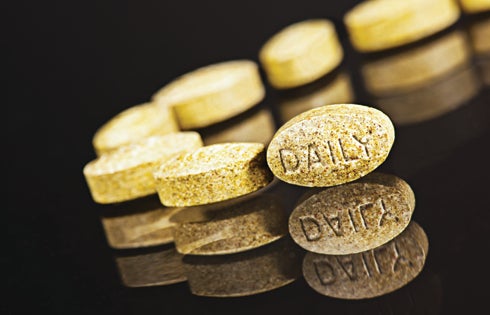Demystifying Multivitamins For Athletes

Photo: Scott Draper/Competitor
By arming yourself with the basic information on how to read multivitamin labels, you’ll end up with the best supplement for you.
As an athlete, you’re always looking for that extra edge. In this eat-on-the run, hustle and bustle world, however, good nutrition is one of those potential advantages that often falls to the wayside. Fortunately, there is a simple, once-a-day ritual that can help fill some of those dietary gaps: the multivitamin.
“Multivitamins cannot replace a healthy eating plan, but they can serve as an insurance policy,” said Jane Pentz Ph.D., of The American Academy of Sports Dietitians and Nutritionists (AASDN).
Nutritionist Monique Ryan, author of “Sports Nutrition for Endurance Athletes,” agrees. “Supplementation should be considered in the context of your diet,” she explained. “It really is the best way to get everything you need on a daily basis.”
While the concept of multivitamins is simple and convenient, the labels that adorn their bottles are not. Prices are across the board, nutrition advice varies and the labels are nearly impossible to interpret. By arming yourself with the basic information on how to read multivitamin labels, you’ll end up with the best supplement for you.
RELATED – Multisport Menu: Drink Your Vitamins
Labeling Basics: Quality Control
The U.S. Food and Drug Administration is charged with providing special labeling requirements for multivitamins. To qualify as a multivitamin, the supplement must contain three or more vitamins and minerals and cannot include herbs, hormones or drugs. While a higher sticker price indicates better quality in some industries, you’re better off understanding the nutritional lingo on the label when choosing a multivitamin. “You can get a good, 100-count multivitamin for around $10,” said Ryan. “You don’t have to spend a fortune.”
Next time you head to the drug store, consider some of the basics:
Quality Control
Look for “USP” or “NSF” on the label. These agencies work to set specific standards for supplements. “This guarantees that the supplement has at least been inspected by a qualified, respected agency and that the amounts on the label correspond with the amounts in the supplement,” explained Pentz.
Get Informed
Research the “tolerable upper limit” (UL) of the various nutrients. You’ll avoid overdose by knowing these numbers. “Individuals should become familiar with UL and be sure not to exceed them,” said Pentz. This is especially important for athletes if they are ingesting a multivitamin along with energy drinks, bars and powders that have added nutrients.
Check Amounts
Many of the “daily values” (DV) listed on vitamin bottles are based on recommendations put forth in the late 1960s. Check out the Institute of Medicine’s Dietary Reference Intakes (DRIs) to determine quantities of certain nutrients you should be taking.
Pay Attention To Unnecessary Labeling
There are a number of fancy terms stamped on vitamin bottles that are simply for marketing purposes. Don’t go out of your way to locate multivitamins with any of the following labels: high potency, senior formula, stress formula, starch-free, natural, slow-release, enzyme hormones, amino acids, PAVA, ginseng or other herbs. “These are typically added for stabilization,” said Pentz.
RELATED: Don’t Play The Nutritional Number Games
Get the latest in triathlon training, gear, nutrition and news sent straight to your inbox. Sign up for Triathlete’s newsletter.